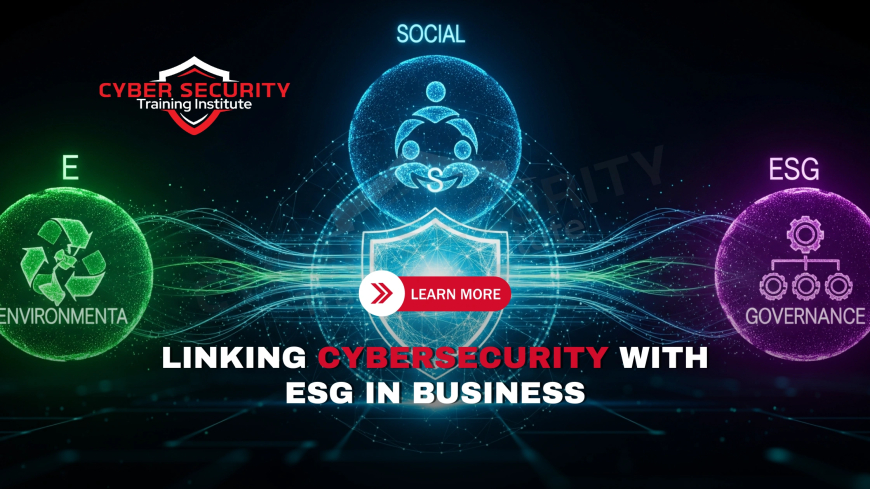How Is Cybersecurity Linked to ESG (Environmental, Social, Governance) in Companies?
In today's digital world, where companies rely heavily on technology to operate, the connection between cybersecurity and ESG—Environmental, Social, and Governance—factors is becoming impossible to ignore. Imagine a major data breach at a big corporation: not only does it expose sensitive customer information, but it can also lead to environmental waste from discarded devices, social distrust in the brand, and questions about the company's leadership decisions. As someone who's followed business trends for years, I've seen how these areas overlap more than ever. This blog post dives into that link, explaining why cybersecurity isn't just an IT issue—it's a core part of building a sustainable, responsible business. Whether you're a business owner, an investor, or just curious about how companies tick, you'll find insights here to help you understand this evolving relationship. Let's explore how protecting data can also protect the planet, people, and proper management.

Table of Contents
- What is ESG?
- What is Cybersecurity?
- The Intersection of Cybersecurity and ESG
- Environmental Aspects: How Cybersecurity Affects the Planet
- Social Aspects: Protecting People and Communities
- Governance Aspects: Building Strong Leadership and Compliance
- Real-World Case Studies
- Benefits of Integrating Cybersecurity into ESG Strategies
- Challenges in Linking Cybersecurity to ESG
- Best Practices for Companies
- Future Trends in Cybersecurity and ESG
- Conclusion
- FAQs
What is ESG?
Before we get into the nitty-gritty, let's break down what ESG really means. ESG stands for Environmental, Social, and Governance—three key areas that investors and stakeholders use to evaluate how responsible a company is beyond just its profits.
- Environmental: This covers how a company impacts the planet, like reducing carbon emissions, managing waste, or conserving resources. Think about a factory cutting down on pollution or a tech firm using renewable energy.
- Social: This focuses on people—employees, customers, and communities. It includes things like fair labor practices, diversity, data privacy, and community involvement. For example, ensuring workers are treated well or protecting user information from misuse.
- Governance: This is about how the company is run. It involves ethical leadership, transparency, risk management, and compliance with laws. Strong governance means having checks and balances to prevent scandals or poor decisions.
ESG isn't just a buzzword; it's a framework that's increasingly influencing investment decisions. Companies with high ESG scores often attract more funding because they show they're thinking long-term about sustainability and ethics. But here's where it gets interesting: cybersecurity plays a role in all three pillars, often in ways you might not expect.
What is Cybersecurity?
Cybersecurity is essentially the practice of protecting computer systems, networks, and data from digital attacks. In simple terms, it's like putting locks on your doors and windows to keep burglars out, but in the online world. These attacks can come from hackers trying to steal information, disrupt operations, or even hold data for ransom.
Common cybersecurity measures include firewalls (which act like barriers against unauthorized access), encryption (scrambling data so only authorized people can read it), and regular software updates to fix vulnerabilities. For beginners, think of it as ongoing maintenance for your digital assets, much like servicing a car to prevent breakdowns.
Why does this matter for businesses? A single cyber incident can cost millions in damages, lost trust, and legal fees. And as we'll see, these incidents ripple out to affect ESG performance, turning a tech problem into a broader corporate responsibility issue.
The Intersection of Cybersecurity and ESG
At first glance, cybersecurity might seem like a purely technical field, separate from ESG concerns. But dig a little deeper, and you'll find they're deeply connected. Cybersecurity threats can undermine a company's environmental efforts, harm social relationships, and expose governance weaknesses. Conversely, strong cybersecurity can enhance ESG ratings by demonstrating responsible management of risks.
For instance, a data breach might force a company to replace hardware en masse, creating electronic waste—an environmental hit. Socially, it erodes customer trust and privacy. From a governance standpoint, it questions the board's oversight. In this section, we'll explore these links in detail, showing how cybersecurity is becoming a must-have for ESG success.
Environmental Aspects: How Cybersecurity Affects the Planet
You might wonder how hacking relates to the environment. It turns out, quite a bit. Cybersecurity breaches can lead to indirect environmental damage. For example, when a company suffers a ransomware attack, they might need to rebuild systems from scratch, discarding old equipment and generating e-waste. E-waste is a big problem—it's toxic and hard to recycle, contributing to pollution.
Moreover, strong cybersecurity can promote sustainability. Data centers, which store company information, consume massive amounts of energy. By optimizing security protocols, companies can reduce unnecessary data storage, lowering energy use and carbon footprints. Some firms even use AI-driven security to predict threats, minimizing resource-heavy responses.
Consider this: According to reports, the ICT sector (information and communications technology) accounts for about 2-3% of global electricity use. Efficient cybersecurity helps streamline operations, cutting down on that. It's a win-win—protecting data while being kinder to the earth.
Social Aspects: Protecting People and Communities
On the social side, cybersecurity is all about safeguarding people. Data privacy is a huge part of this. When companies handle personal information—like emails, health records, or financial details—they have a social responsibility to keep it secure. A breach can lead to identity theft, which harms individuals and erodes public trust.
Beyond privacy, cybersecurity prevents social harms like the spread of misinformation or cyberbullying on platforms. For social media companies, robust security measures ensure safer online spaces, aligning with ESG's social pillar. It also supports employee well-being; think about remote workers who need secure connections to avoid stress from potential hacks.
In communities, companies with good cybersecurity contribute positively by sharing threat intelligence, helping smaller businesses or nonprofits stay safe. This builds social capital and shows a commitment to broader societal good.
Governance Aspects: Building Strong Leadership and Compliance
Governance is where cybersecurity shines as a risk management tool. Boards and executives must oversee cyber risks, just like financial or legal ones. This includes setting policies, conducting audits, and ensuring compliance with regulations like GDPR (General Data Protection Regulation), which mandates data protection.
Poor governance in cybersecurity can lead to scandals, fines, and shareholder lawsuits. On the flip side, transparent reporting on cyber incidents boosts investor confidence. Many ESG frameworks now include cybersecurity metrics, like how quickly a company responds to threats or trains staff.
Essentially, good governance treats cybersecurity as a board-level priority, integrating it into overall strategy for long-term resilience.
Real-World Case Studies
To make this concrete, let's look at some examples. Take the 2021 Colonial Pipeline hack. Ransomware shut down fuel supplies, causing environmental risks from potential spills and social panic with gas shortages. Governance-wise, it highlighted poor preparedness, damaging the company's reputation.
Another is Equifax in 2017. A breach exposed 147 million people's data, leading to social harm through identity theft and governance failures in patching known vulnerabilities. Environmentally, the fallout included increased paper use for notifications and hardware upgrades.
On the positive side, Microsoft's cybersecurity investments have improved its ESG scores. By focusing on secure cloud services, they've reduced energy waste (environmental), enhanced user privacy (social), and demonstrated strong oversight (governance).
Benefits of Integrating Cybersecurity into ESG Strategies
Linking cybersecurity to ESG isn't just about avoiding risks—it's about gaining advantages. First, it attracts investors who prioritize sustainable practices. Companies with solid cyber-ESG integration often see higher stock values.
Operationally, it leads to efficiency. Secure systems mean fewer disruptions, saving money and resources. Socially, it builds brand loyalty; customers prefer companies that protect their data.
Here's a quick table summarizing key benefits:
| ESG Pillar | Cybersecurity Benefit | Example Impact |
|---|---|---|
| Environmental | Reduced e-waste and energy use | Fewer hardware replacements after breaches |
| Social | Enhanced data privacy | Increased customer trust |
| Governance | Better risk management | Compliance with laws, avoiding fines |
Overall, this integration fosters innovation, like developing green security tech.
Challenges in Linking Cybersecurity to ESG
Of course, it's not all smooth sailing. One big challenge is measurement—how do you quantify cybersecurity's ESG impact? Metrics aren't standardized, making it hard to report.
Resource constraints hit smaller companies hard; they might lack the budget for advanced security while chasing ESG goals. There's also the skills gap: Not enough experts who understand both fields.
Regulatory changes add complexity, as laws evolve differently across regions. Finally, balancing security with usability can frustrate users, potentially affecting social aspects.
Best Practices for Companies
To overcome these, companies can adopt simple steps. Start with leadership buy-in: Make cybersecurity a C-suite priority.
- Conduct regular risk assessments that include ESG factors.
- Train employees on basic security hygiene, like strong passwords.
- Partner with third-party auditors for unbiased reviews.
- Integrate sustainability into security, like using energy-efficient tools.
- Report transparently on cyber incidents in ESG disclosures.
These practices don't require fancy tech—just commitment and planning.
Future Trends in Cybersecurity and ESG
Looking ahead to 2025 and beyond, AI will play a bigger role. AI can predict threats, reducing reactive measures that waste resources. Quantum computing might challenge current encryption, pushing for greener alternatives.
Regulations will tighten, with more mandates linking cyber to ESG reporting. Expect growth in "cyber-ESG" certifications. Also, as remote work persists, securing distributed networks will tie into social well-being.
Sustainability-focused cyber tools, like low-energy firewalls, will emerge. Companies that adapt early will lead the pack.
Conclusion
In wrapping up, we've seen how cybersecurity is woven into the fabric of ESG. From minimizing environmental waste to upholding social trust and strengthening governance, secure practices are essential for responsible business. Ignoring this link risks not just data loss but broader reputational and sustainability hits. By integrating cybersecurity into ESG strategies, companies can build resilience, attract investment, and contribute positively to society. It's a reminder that in our connected world, protecting bits and bytes is about protecting our shared future. If this sparks your interest, dive into your own company's policies—small changes can make a big difference.
FAQs
What exactly is ESG, and why should companies care?
ESG refers to Environmental, Social, and Governance criteria used to assess a company's sustainability and ethical impact. Companies care because strong ESG performance attracts investors, improves reputation, and ensures long-term viability in a world focused on responsibility.
How does cybersecurity fit into environmental concerns?
Cybersecurity prevents breaches that lead to e-waste from discarded devices and optimizes data centers to reduce energy consumption, lowering a company's carbon footprint.
Can a data breach affect a company's social responsibility?
Yes, breaches compromise user privacy, leading to identity theft and loss of trust, which directly harms social aspects like community well-being and customer relationships.
What role does governance play in cybersecurity?
Governance ensures leadership oversees cyber risks, sets policies, and complies with laws, treating security as a core part of ethical management.
Are there regulations linking cybersecurity to ESG?
Yes, laws like GDPR and emerging ESG reporting standards require companies to disclose cyber risks and protections as part of governance transparency.
How can small businesses integrate cybersecurity with ESG?
Start with basic measures like employee training and regular audits, focusing on affordable tools that also support sustainability goals.
What are some common cybersecurity threats impacting ESG?
Ransomware, phishing, and data leaks can cause environmental waste, social harm from privacy violations, and governance failures through poor response.
Does improving cybersecurity boost ESG scores?
Absolutely—agencies like MSCI or Sustainalytics factor in cyber resilience when rating companies, leading to better overall ESG evaluations.
How does AI influence the cybersecurity-ESG link?
AI enhances threat detection, reducing resource use (environmental) and improving privacy protections (social), while aiding governance through predictive analytics.
What happens if a company ignores cybersecurity in its ESG strategy?
It risks fines, reputational damage, investor pullout, and operational disruptions that undermine all ESG pillars.
Can cybersecurity help with diversity and inclusion?
Yes, secure systems protect sensitive employee data, fostering an inclusive workplace where diverse groups feel safe sharing information.
How do investors view the cybersecurity-ESG connection?
Investors see strong cybersecurity as a sign of good governance and risk management, making companies more attractive for ESG-focused funds.
What tools can companies use for cyber-ESG integration?
Frameworks like NIST for cybersecurity and SASB for ESG reporting help align the two, with software for tracking metrics.
Is there a cost to linking cybersecurity and ESG?
Initial investments in training and tech exist, but long-term savings from avoided breaches often outweigh them.
How does remote work affect this link?
Remote setups increase cyber risks, impacting social well-being (employee security) and requiring governance to enforce secure practices.
What's the environmental impact of poor cybersecurity?
Breaches can lead to mass hardware replacements, increasing e-waste and energy demands for recovery efforts.
Can cybersecurity enhance community engagement?
By sharing security best practices or supporting local cyber education, companies build social ties and improve ESG standing.
What future challenges might arise in this area?
Evolving threats like quantum hacking could demand new, sustainable security methods to maintain ESG alignment.
How do case studies illustrate this connection?
Events like the SolarWinds hack show how breaches cascade into environmental, social, and governance issues, emphasizing the need for integration.
Why is transparency important in cyber-ESG?
Transparent reporting builds trust, satisfies governance requirements, and allows stakeholders to assess real progress in both areas.
```
What's Your Reaction?
 Like
0
Like
0
 Dislike
0
Dislike
0
 Love
0
Love
0
 Funny
0
Funny
0
 Angry
0
Angry
0
 Sad
0
Sad
0
 Wow
0
Wow
0










![How to Install RHEL 10 on VMware/VirtualBox [Tutorial]](https://www.cybersecurityinstitute.in/blog/uploads/images/202509/image_430x256_68b56dc967a4a.jpg)





